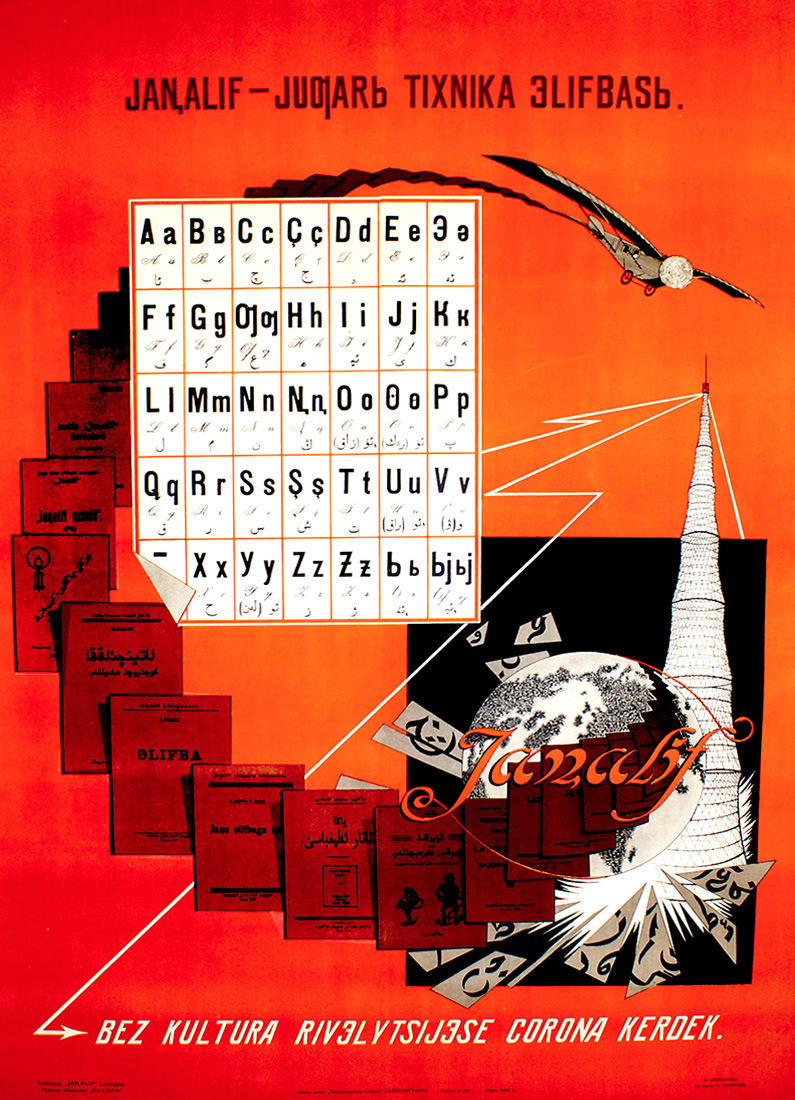
The New Alphabet - An Alphabet of high technology. We have entered the period of Cultural Revolution.
Poster Number: PP 604
Category: Education & Literacy
Poster Notes: [Lower left]: The word "Janalif" (New Alphabet) is seen breaking through the Arabic script while the radio transmitter in Moscow (built in 1928) broadcasts information.
Media Size: 39x32.5
Poster Type: Lithograph and Offset
Publishing Date: c.1928
Technical Information on Poster: Order No. 81.
Print Run: 10,000
Glavlit Directory Number: 1261
Catalog Notes: PP 604 Education & Literacy
Language: Tatar
Artist: Tagirov, Faik Shakhirdzhanovich — Тагиров, Фаик Шахирджанович
Faik Tagirov was born in a small village located in what is today Tatarstan, Russia. For over 60 years he worked in graphic design and publishing in the Soviet Union and he was a part of the literary scene of the Tatar Autonomous Soviet Socialist Republic early in his career. Although he was a Kazan-based artist, Tagirov spent the majority of his life in Moscow. Beginning in 1925, he studied at VKhUTEIN (Higher Art and Technical Institute) ...
Read More About This Artist
Artist: Kronevald (Kroneval’d), Nikolai Nikolaevich — Кроневальд, Николай Николаевич
Although he was born in the Russian city of Astrakhan, Nikolai Nikolaevich Kronevald lived in Kazan for most of his life. Very little is known about Kronevald’s personal life, and information concerning the artist's career is scarce. However, one published source indicates that his family was of German descent. Kronevald worked for the Tatar State Publishing House where he specialized in graphic art. In 1936, Kronevald was arrested for depicting a "fascist swastika" on...
Read More About This Artist
Printer: Tatpoligraf, Kazan — Татполиграф, Казань
Tatpoligraf (Tatar Poligrafic Enterprise) was a printing trust formed in 1927 to consolidate printing houses in the Tatar Autonomous Soviet Socialist Republic that were outside the jurisdiction of Tatgosizdat (Tatar State Publishing House). The headquarters of Tatpoligraf was in Kazan at 4 Miskavskii Street. For example, the Kazan-based printers of Vostok Lithography (at 4 Kazanskaia Street) and Proletarskoe Slovo (Proletarian Word) Lithography were under the management of Tatpoligraf.
Read More About This Printer
Publisher: Janalif (Jaꞑalif) Society, Kazan — Издание Общества «Яналиф», Казань
The Janalif Society was based in Kazan, the capital city of the Tatar Autonomous Soviet Socialist Republic. The Society was formed in 1926 with the aim of replacing the traditional Arabic-based script used for the Tatar language with a new, Latin-based script. From 1927 to 1928, the alphabet was reformed to thirty-three letters and it was called the Janalif (Unified Turkic Alphabet).
Read More About This Publisher